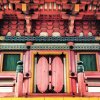Prior to construction in 1964 of the Tokaido Shinkansen bullet train, connecting Tokyo with Kyoto and Osaka, the original route between the new and old capitals took travelers through the Hokuriku region of northwest Japan. Join us as we follow this historic route that takes in samurai castles, mountain monasteries, and UNESCO sites - all on the newly developed high-speed Hokuriku Shinkansen route.
Tokyo Station
As the starting or endpoint of your shinkansen bullet train journey, Tokyo Station is going to be part of almost every Hokuriku golden route adventure. It is also a destination in its own right. The 1914 main red brick building is not only beautifully preserved but still in use. Take your time to admire the historic domes of the Marunouchi side of the station that faces the Imperial Palace.
Hieizan Enryakuji Temple in Shiga
Founded in 788, the monastery complex is the headquarters of the large, influential esoteric Tendai Buddhist sect. Tucked away in the forests of the sacred mountain Hieizan, this temple has two main areas connected by tranquil forest paths. The velvety darkness of the main hall evokes the rigorous practices endured by countless generations of monks on their way to enlightenment.
Takayama Jinya (Historical Government Office in Gifu)
This is the only one now remaining of about 60 governmental offices that oversaw local matters for the Edo Period (1603–1868) Tokugawa government. It managed the area’s local affairs and prolific timber production among other industries. As you tour the buildings, enjoy spacious tatami rooms, old-style kitchens, formal gardens, and a daily morning market with food and folk craft items.
Kehi Jingu Shrine in Fukui
To enter this ancient shrine, dating from 702, you must pass under a wooden torii gate, one of the three largest in Japan. Inside, you can walk the picturesque red pillared corridors, visit the statue of famous haiku poet Matsuo Basho (who visited here in 1689), and view the sacred spring Chomeisui, which has been flowing continuously since the shrine’s founding.
Tomioka Silk Mill in Gunma
The first modern silk-reeling factory in Japan, now a World Heritage site, the mill was built in 1872 as a model factory during the Meiji Restoration when Japan adopted Western industrial techniques. Three handsome brick buildings, which housed the factory and storerooms, may be toured, along with the sumptuous home of the first French director Paul Brunat.
Kenrokuen Garden in Kanazawa
Take a stroll through this 17th-century park, which is listed as one of the top-three landscaped gardens in Japan. The 28-acre garden is filled with countless iconic views all along the many walkways. Explore for yourself and discover serene waterfalls, dense plum tree groves, Japan’s first fountain, and much more!
Menuma Shodenzan Kangiin Temple in Saitama
This temple complex north of Tokyo has a one-thousand-year history. The main hall is a National Treasure with extraordinarily elaborate colorful wood carvings tricked out in gold. After viewing these, take a walk around the peaceful natural complex with its many buildings and statues. The main deity, the Great Sage Kangiten, confers good fortune, especially in marriage and family matters.
Fushimi Inari-taisha Shrine in Kyoto
This famous Shinto shrine is sacred to the Inari fox god of rice, who confers good fortune in business ventures. Walk under thousands of vermilion torii gates forming tunnels that wind up the mountain. After coming down, wander the quaint shopping streets and try local delicacies such as inari-sushi and kitsune udon noodles.
Sado Kinzan Gold Mine in Niigata
The highlights of this 400-year-old gold mine on historic Sado Island are the two walking tours through the actual tunnels, which saw over 78 tonnes of gold and 2330 tonnes of silver leave the mine in the 388 years it was in operation. One tour features animatronic figures showing what it was like to work in the original mines. The other shows more modern Meiji Period (1868–1912) mining methods. There is also a museum packed with information.
Historic Village of Gokayama in Toyama
The mountain village of Gokayama is preserved as a UNESCO World Heritage site and boasts a legacy that dates far back to Japan’s prehistoric Jomon Period. The distinct gassho-zukuri architecture has been honed by the surrounding nature, using every last natural resource available, to withstand the dense snowfall that comes each year. A visit today is like stepping back through the centuries to a simpler time.
Matsumoto Castle in Nagano
Built between 1593-594, Matsumoto Castle is a National Treasure and the country’s oldest five-tiered six-story wooden castle. During your walk around the grounds, look out for the samurai warriors and ninjas who are on-site daily. Be sure to arrive early in the morning and walk around the moat to catch the tranquil reflection of the castle and vermillion Uzumibashi Bridge in the water.
Osaka Castle
The first thing you will notice about this castle is the magnificent stone wall rising up to 65 feet on both sides of the inner moat. The castle park expands over 263 acres and is popular in spring for its beautiful cherry blossoms, as well as its 1,270 apricot trees. For history buffs, the castle museum is also one of the most comprehensive you will find in Japan.
For more information on rail passes, routes, and everything you need to plan your Hokuriku adventure, please visit the Explore Japan website below.
Explore Japan Official Website
https://www.westjr.co.jp/global/en/ticket/hokuriku-arch-pass/Explore_Japan/
Visit the official Hokuriku Arch Pass website here:
https://www.westjr.co.jp/global/en/ticket/hokuriku-arch-pass/

More info
Find out more about Sado Kinzan.


























